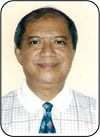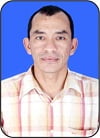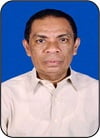Heterogeneity in Torajan Ritual Speech: Metalinguistic Awareness and the Nation’s Character Building
Abstract
ABSTRACT: The research is aimed at studying heterogeneity in Torajan ritual speech through the process of entextualization. The research shows that in the event of speaking by a single speaker, there occurs the process of the decontextualized text segments from other genres of prose narrative, such as historical narratives, myths, legends, and poetic argumentation, which is then recontextualized in the present performance. The method used is participant observation. The field notes are analyzed from domain, taxonomic, componential, and thematic analysis. The techniques used are recording, videotaping, and field notes. The research has two findings: ethnographic and academic. Ethnographically, it is found that the Torajan ritual speech spoken by a single speaker, the “tomina”, is actually heterogeneous. Theoretically, it shows that homogeneity in language is tenable only if evaluation is based on grammar. However, this research is able to show the heterogeneity in Torajan ritual speech. The sources of the texts are “retteng”, poetic argumentation, and the myth of “Tulang Didi”. The values of the three forms of life, such as human beings, animals, and plants, are found. From this appear, the harmonious relations between human and God, human and human, human and animals, and human and plants. These values may contribute to the nation’s character building.
KEY WORD: Heterogeneity, metalinguistic awareness, entextualization, ritual speech, nation’s character building, and Toraja people.
RESUME: “Heterogenitas dalam Tuturan Ritual Toraja: Kesadaran Metabahasa dan Pembangunan Karakter Bangsa”. Penelitian ini bertujuan untuk mempelajari heterogenitas dalam tuturan ritual di Toraja lewat proses entekstualisasi. Hasil penelitian menunjukkan bahwa dalam peristiwa tutur yang dilakukan oleh seorang penutur terjadi proses dekontekstualisasi segmen teks dari jenis-jenis narasi prosa, seperti narasi historis, mitos, legenda, dan argumentasi puitik yang direkontekstualisasikan ke dalam performansi sekarang. Metode yang dipakai adalah observasi partisipan. Hasil catatan lapangan dianalisis dari sudut domain, taksonomik, komponensial, dan tematis. Teknik penelitian yang dipakai adalah rekaman, video, dan catatan lapangan. Ada dua hasil penelitian: etnografi dan akademik. Secara etnografis, tuturan ritual Toraja yang dituturkan oleh satu orang, “tomina”, sebenarnya heterogen. Secara teoretis, diketengahkan bahwa homogenitas dalam bahasa hanya bisa dipertahankan kalau dilihat dari sudut tata bahasa. Namun, penelitian memperlihatkan heterogenitas dalam tuturan ritual Toraja. Sumber-sumber teks adalah “retteng”, argumen puitik, dan ceritera Tulang Didi. Ditemukan nilai-nilai tiga pucuk kehidupan, seperti manusia, hewan, dan tanaman. Nilai-nilai ini memperlihatkan relasi antara manusia dengan Yang Kuasa, manusia dan manusia, manusia dan hewan, serta manusia dengan tanaman. Nilai-nilai ini dapat dipakai untuk memperkokoh pembangunan karakter bangsa.
KATA KUNCI: Heterogenitas, kesadaran metabahasa, entekstualisasi, tuturan ritual, pembangunan karakter bangsa, dan bangsa Toraja.



About the Authors: Stanislaus Sandarupa, R.S.M. Assagaf & Husain Hasyim are Lecturers at the Faculty of Humanities UNHAS (Hasanuddin University) Makassar, Jalan Perintis Kemerdekaan Km.10, Makassar City, South Sulawesi, Indonesia. Corresponding author is: torindo@indosat.net.id
How to cite this article? Sandarupa, Stanislaus, R.S.M. Assagaf & Husain Hasyim. (2015). “Heterogeneity in Torajan Ritual Speech: Metalinguistic Awareness and the Nation’s Character Building” in SOSIOHUMANIKA: Jurnal Pendidikan Sains Sosial dan Kemanusiaan, Vol.8(1) Mei, pp.29-38. Bandung, Indonesia: Minda Masagi Press, UNHAS Makassar, and UNIPA Surabaya, ISSN 1979-0112.
Chronicle of the article: Accepted (April 28, 2015); Revised (May 20, 2015); and Published (May 30, 2015).
Full Text:
PDFReferences
Acciaioli, G. (1985). “Culture as Art: From Practice to Spectacle in Indonesia” in Canberra Anthropology, 8, pp.148-190.
Adams, K. Marie. (1988). “Carving a New Identity: Ethnic and Artistic Change in Tana Toraja, Indonesia”. Unpublished Ph.D. Thesis. Washington DC [District of Columbia]: University of Washington.
Adams, K. Marie. (1990). “Cultural Commoditization in Tana Toraja, Indonesia” in Cultural Survival Quarterly, 14, pp.31-34.
Adams, K. Marie. (2006). Art as Politics. Hawa'i: University of Hawa'i Press.
Bakhtin, M. (1981). The Dialogic Imagination. Austin: University of Texas Press, firstly published in 1935.
Bauman, R. & C.L. Briggs. (1990). “Poetics and Performance as Critical Perspectives on Language and Social Life” in Annual Review of Anthropology, 19, pp.59-88.
Bigalke, Terance William. (2005). Tana Toraja: A Social History of an Indonesian People. Singapore: Singapore University Press.
Conklin, H.C. (1964). “Linguistic Play in its Cultural Context” in D. Hymes [ed]. Language in Culture and Society. New York: Harper & Row Publishers, pp.295-300.
Crystal, E. (1989). “Tourism in Toraja (Sulawesi, Indonesia)” in V. L. Smith [ed]. Hosts and Guests. Philadelphia: University of Pennsylvania Press.
Fox, J.J. [ed]. (1988). To Speak in Pairs: Essays on the Ritual Languages of the Eastern Indonesia. Cambridge: Cambridge University Press.
Hanks, William F. (1996). Language and Communicative Practices. Boulder, Colo: Westview Press.
Koubi, J. (1982). Rambu Solo', La Funmee Descend: Le Cults de Morts Chez les Toradja du Sud. Paris: Centre Nationalde la Recherce Scientific.
Listyarti, Retno. (2012). Pendidikan Karakter dalam Metode Aktif, Inovatif, dan Kreatif. Jakarta: Penerbit Erlangga.
Nooy-Palm, H. (1979). The Sa'dan Toraja: A Study of Their Social Life and Religion, Organization, Symbols, and Beliefs. The Hague: Martinus Nijhoff.
Nooy-Palm, H. (1986). The Sa'dan Toraja: A Study of Their Social Life and Religion, Rituals of the East and West. Dordrecht: Foris Publications.
Payne, James. (2001). Applications Communication: For Personal and Professional Contexts. Topka: Clark Publishing Inc.
Peirce, C.S. (1955). “Logic as Semiotic: The Theory of Signs” in J. Buchler [ed]. Philosophical Writings of Peirce. New York: Dover Publications, Inc., firstly published in 1940.
Rappoport, Dana. (2009). Songs from the Thrice-Blooded Land: Ritual Music of the Toraja (Sulawesi). Paris: Edition de la Maison de Sience de l'Home.
Sandarupa, S. (2004a). “The Exemplary Center: Poetics and Politics in the Kingly Death Ritual in Toraja, South Sulawesi, Indonesia”. Unpublished Ph.D. Dissertation. Chicago: The University of Chicago.
Sandarupa, S. (2004b). The Exemplary Center: Poetics and Politics in the Kingly Death Ritual in Toraja, South Sulawesi, Indonesia. Michigan: UMI Proquest.
Sandarupa, S. (2013). “The Poetry of Taking Power in Toraja, South Sulawesi, Indonesia” in Research on Humanities and Social Sciences, 3.
Sandarupa, S. (2014). “The Voice of a Child: Constructing a Moral Society Trough Retteng Poetic Argumentation in Toraja”. Paper presented in an International Conference on Language and Technology, organized by UIN (State Islamic University) Makassar.
Silverstein, M. (1976). “Shifters, Linguistic Categories, and Cultural Descriptions” in K.H. Basso & H.A. Selby [eds]. Meaning in Anthropology. Albuquerque: University of New Mexico Press, pp.11-55.
Silverstein, M. (1981). “The Limits of Awareness”. Working Papers in Sociolinguistics. Albuquerque: University of New Mexico Press.
Silverstein, M. (1993). “Metapragmatic Discourse and Metapragmatic Function” in J.A. Lucy [ed]. Reflexive Language: Reported Speech and Metapragmatics. New York: Cambridge University Press.
Silverstein, M. (2001). “Functions” in D. Alessandro [ed]. Key Terms in Language and Culture. Nassachusettes: Blackwell Publisher.
van End, D. (1994). Sumber-sumber Zending tentang Sejarah Gereja Toraja, 1901-1961. Jakarta: PT BPK Gunung Mulia.
Veen, v.d. (1965). The Merok Feast of the Sa'dan Toraja. 's-Gravenhage: Martinus Nijhoff.
Veen, v.d. (1966). The Sa'dan Toraja Chant for the Deceased. ‘s-Gravenhage: Martinus Nijhoff.
Volkman, T. (1985). Feasts of Honor: Ritual and Change in the Toraja Highlands. Urbana and Chicago: University of Illinois Press.
Waterson, Roxana. (2008). Paths and Rivers: Sa'dan Toraja Society in Transformation. Leiden: KITLV Press.
SOSIOHUMANIKA: Jurnal Pendidikan Sains Sosial dan Kemanusiaan is published by Minda Masagi Press. This work is licensed under a Creative Commons Attribution-Sharealike 4.0.
